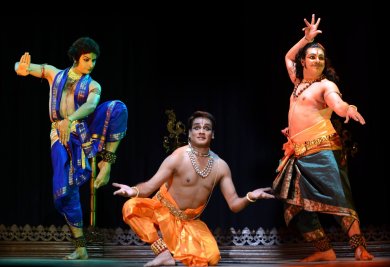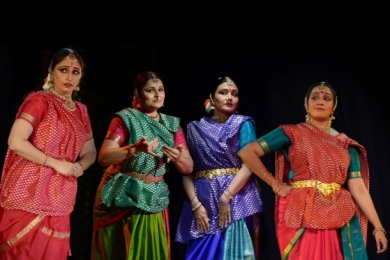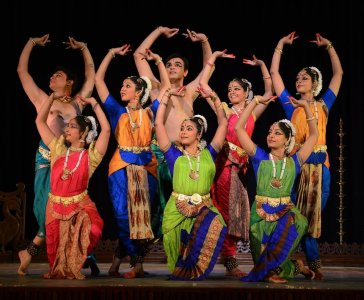
|   |

|   |
Nayaka-Nayika Festival - Poornima Gururaja e-mail: kalasindhudance@gmail.com October 7, 2014 The inaugural lamp placed at an unusual location in the back center of the stage, at the outset caught the attention of the audience and the guests of honour, Manju Bhargavi and Mysore V. Subramanya at the opening of the two day Nayaka-Nayika Festival conceptualised by art consultant Usha Rk. Six talented dancers opened the festival with a vibrant pushpanjali on an aesthetically pleasing stage set by Bangalore dancer Sathyanarayana Raju. Usha Rk’s brief and accurate compering introduced and walked the audience through the first day’s concept, Navarasa Nayaka. The concept was developed around the theme of Lord Shiva and his attributes. Sathyanarayana Raju portrayed a sensual yet restrained and mature sringara aspect of the lord Shiva which is quite rare. Impressive were the lyrics “Jaya Sundari, talavakilu teeyave, jagadeeshwarude komma” penned especially for the episode by vocalist D.S Srivatsa. Shiva lets his matted locks loose to encircle and bring close his Parwati, who finds herself entangled and up close in front of her lord is enamoured to see this romantic form of Shiva. Sathya’s depiction of this was restrained and dignified. Following this was Surya Rao’s portrayal of karuna through the story of Bhakta Markandeya. Surya opted to tell the story through the medium of Kuchipudi and movements of Bhagavatha Mela Natakam. His performance could have used a bit of subtlety when it came to portraying Markandeya as a child, and over the top vatsalya did not sit well on lord Shiva. Pavitra Bhat from Bombay told the story of Kama Dahana, for roudra rasa. His execution of the arrows Kama aims at lord Shiva were more impactful than the actual burning down of the god of love.  Pavitra Bhat, Sathyanarayana Raju, Surya Rao
A ninda stuti penned by D.S. Srivatsa “Moodu kaanula vadito prema yenduko?” brought out an effective hasya rasa, performed by Sathyanarayana Raju. The choreography was as creative as the lyrics were. Kirata and Arjuna’s war over who shot a wild boar first, and Arjuna losing a long fought battle, and realizing that he has lost to none other than lord Shiva himself, bowing down to him and receiving the pashupatastra set the backdrop for the veera rasa. The vikaaara and vairaagya elements of lord Shiva were meant to communicate the bhibatsa rasa. Surya's performance was energetic and convincing. Vairagya comes from Shiva being Mrityunjaya or the conqueror of death. Bhibatsa is evoked on seeing the ease with which he wears the chitabhasma. The justification of why the attributes of Shiva evoke bhibatsa rasa was missing leading to a very weak expression of bhibatsa. Sathyanarayana Raju’s composition of Shiva being the holder of contrasting elements such as agni, apa and soma were short of effective in depicting adbhuta rasa. Surya Rao by choosing to essay the role of Bhasmasura, completely missed the point of bhayanaka. Shiva’s fear shown at least once during the chase would have added to the impact of the rasa. The rasa it portrayed was Bhasmasura’s veera, with his energetic enactment of the asura. The rasa it evoked in the audience was one of awe and laughter at Bhasmasura’s chasing Shiva. Shantha rasa by Pavithra Bhat was convincing as was his impeccable angika. The performance ended with a tillana in Sumanasaranjini by the young dancers who opened the performance. The delicate and challenging point of creating a Navarasa piece is to decide at the onset whether the dancer will portray a bhava and evoke rasa as in nritya, or the dancer plays the protagonist and experiences the rasa that transmits into the audience as in natya. Few of the rasas were executed as nritya and few as natya, maybe because of different styles of dance that the dancers adopted to portray the rasas. The second day’s performance began with a solemn note. After Usha had spoken of Mandolin Srinivas and her long standing professional relationship with him, a minute’s silence was observed in honour of his memory. The day’s presentation began with a pushpanjali by the young dancers brigade. The Nayika presentation began with “Varijamukhi...” in raga Kamas set to rupaka talam. Uma Sathyanarayanan’s performance was neat. Her presentation of the khandita nayika was powerful as it ought to be. “Arivenaiyya un antharangam ...” in raga Atana set to tala rupakam a composition of Dharmapuri Subbarayar was an apt choice. The choice of “Samayamide ra ra...” in the raga Behag to rupaka tala made one sit up and watch how it was going to take shape as a depiction of the vasakasajja as its sthyai. The opening itself created a prosutapatika nayika feel, diluting the sthayi at the outset. Although Poornima Ashok’s creativity and ingenuity in the choice of a piece was accepted into the framework of the presentation, except for few glimpses of the nayika decking herself with the jewellery given by her patron, and a brief decoration of a lover's bed there were no emphatic elements of a vasakasajja. Her spinning all the sancharis she did with a parakeya nayaka around their respective aharyas would have created more impact. Her depiction of the proshitabratuka nayika was convincing. The choice of “Ninnu chooda galgane innaluku....” (raga Punnagawarali, tala tisra triputa) with the nayaka being present and the nayika addressing him directly was a rare choice, as was the choice of raga for the piece.  Soundarya Srivatsa, Subhashini Vasanth, Poornima Ashok, Uma Sathyanarayanan Soundarya Srivatsa easily stood out with her playing the swadeenapathika nayika supported by the song “Smarasundaranguni...” in raga Paras and adi talam. The piece started with a brisk pace and seemed well rehearsed and thought out. This was not the case with the kalahantarita nayika in the song “Netru varen enru....” (raga Pantuvarali, tala mishra chapu). The line “Aatrum karaidanile, andhi pozhudinile....” the dancer depicted taking a bath, when “andhi pozhudinile” clearly means evening. A more convincing depiction would have been showing the birds coming home, a sunset, when all the girls have filled their water pots and left for home. Then saying ‘he came to me when no one was there or looking’ would have flowed well. Speaking of artistic liberties on the other hand, who says one cannot bathe in the evenings? Subhashini Vasanth took on the virahotkantita nayika, with the all familiar kriti “Sakhi Prana...” in raga Jenjuti, adi talam. She held the sthayi well through the presentation. Her “Yarukkagilum bhayama” in raga Begada set to misra chapu talam flowed rather typically till the line “rajangamagilum....” It was interpreted as the nayika saying, “I am now royalty because I am the chosen one” as opposed to what is often depicted as “If I were royalty would people talk about me thus?”  Standing: Yogesh, Nikitha, Arun, Anju, Aditi First row: Pruthvi, Chaitra and Gowri The performance ended with the same tillana as the first day. The presentation had the outstanding vocal support of D.S. Srivatsa and Vasudha Balakrishna. They were ably supported on nattuvangam by Shakuntala Prabhath, on the mridangam by Balakrishna, on the flute by Raghunandan and Shubha Santosh on the veena. The two day festival took place at the Bangalore Gayana Samaja on the 18th and 19th of September 2014. Usha Rk has to be lauded for her effort in conceiving ideas that provoke a younger generation of artists to explore genres such as padams and javalis, which are complex and challenging. She brought together artists from different parts of the country, different styles and gurus. As enjoyable as it was, it also raised several pertinent questions in the minds of thinking dancers, as it ought to have. Poornima Gururaja, a disciple of Guru Narmada, is an exponent of the Pandanallur / Tanjore School of dance. She founded the Kalasindhu Academy of Dance and Related Arts in 2009 in Bangalore. |